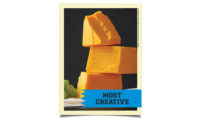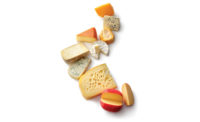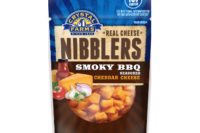
The new Dietary Guidelines for Americans contain some good news/bad news for U.S. cheesemakers. Good news: Americans like to eat cheese. The food is among the Top 25 sources of calories for children and adults. Bad news: eat dairy foods other than cheese, the government says.
The DGA recommends that Americans “increase intake of fat-free or low-fat milk and milk products, such as milk, yogurt, cheese or fortified soy beverages.” But that suggestion is tempered by the government’s message that Americans should consume “more fat-free or low-fat vitamin D-fortified milk or yogurt than cheese.”
While Uncle Sam does encourage the consumption of low-fat cheeses (along with low-fat milk), the DGA comes down hard on full-fat dairy products. That’s because the guidelines recommend that Americans decrease their intake of solid fats and sodium. Both elements are found in full-fat cheeses.
Regular cheese accounts for 3.5% and pizza for 6.3% of the sodium in the American diet. The guidelines recommend that an adult consume no more than 2,300 milligrams of sodium daily, meaning adults have their work cut out for them. They already consume more than that quantity on a daily basis.
Shoppers do have choices and alternatives. As Dairy Management Inc., Rosemont, Ill., points out, “There are currently reduced- and low-sodium cheeses in the marketplace and some cheeses are naturally lower in sodium like Swiss and fresh mozzarella.”
Under the auspices of DMI’s Innovation Center for U.S. Dairy, a best practices group of nearly 20 cheese companies and manufacturers are addressing the opportunities and challenges associated with reducing sodium content in cheese. The group says it has been working “pre-competitively to improve consumers’ health and wellness while maintaining strict expectations for food safety and taste.” The group also is working to maintain taste and functionality in lower-sodium products, update process controls in manufacturing and educate key audiences about the necessary role of sodium in cheese.

Cut down on fats
Major sources of solid fats in Americans’ diet are “grain-based des-serts (11% of all solid fat intake); pizza (9%); regular (full-fat) cheese (8%); sausage, franks, bacon and ribs (7%); and fried white potatoes (5%),” according to the DGA.The DGA sends a mixed signal regarding cheese. On one hand, the guidelines state, “When selecting cheese, choose low-fat or reduced-fat versions.” On the other, there’s this: “Choose fat-free or low-fat milk or yogurt more often than cheese. Milk and yogurt are better sources of potassium and are lower in sodium than most cheeses. Also, most milk is fortified with vitamin D.”
The guidelines do see a companion role for cheese. For example, to encourage the consumption of more vegetables, the government suggests pairing them with reduced-fat cheese sauces.
Dairy products rate highly for their calcium content, and cheese fares particularly well, compared to other dairy foods (see table). Cheesemakers and cheese marketers need to be creative to ensure that consumption does not drop off in light of the government’s latest recommendations. First Lady Michelle Obama has made it clear that she’s not against eating or serving high-fat foods for herself or her family. The White House served bratwurst, cheeseburgers and deep dish pizza at a Super Bowl party in February, and Mrs. Obama allows her daughters to eat pizza on weekends.
Cheesemakers are taking their message about cheese directly to consumers with marketing campaigns and traveling exhibits.

Non-traditional pairings
Wine and cheese, cheese and crackers and macaroni and cheese are classic pairings. In California, the cheese industry is pushing a new partner. Instead of roses for Valentine’s Day, the California Milk Advisory Board told lovers to “say it with cheese” with a menu of chocolates and California cheeses. The CMAB called the pairing “a savory-sweet love connection sure to stand the test of time and taste.”The state’s 50-plus cheesemakers produce more than 250 varieties and styles of cheese, including bandage-wrapped Cheddar and Brie. The board says foods with similar flavor profiles go well together. Darker chocolates pair best with more complex aged cheese, while sweet milk chocolates complement buttery cheeses like Brie. Fruity chocolates and sharper cheeses go together, as do nuttier chocolates and high butterfat cheeses.
The board created a tasting table at its website,RealCaliforniaCheese.com/recipes. A smart phone app called “Pair Savvy” for iPhone and Android devices is available atpairsavvy.realcaliforniamilk.com.
Taking it to the streets
In February, Tillamook Cheese, the 102-year-old farmer-owned dairy brand, embarked on the second annual cross-country event, which started in Phoenix. A custom-refurbished convertible mini-bus, called the Loafster, is traveling through Arizona, California, Colorado and Utah to “bring tasty cheese to the people,” the company says. The Loafster, created from a 1966 VW Microbus, resembles baby loafs of Tillamook Cheddar cheese. The on-the-road campaign is akin to the Oscar Mayer’s traveling Wienermobile.Product demonstrators set up a 10-foot by 10-foot tent in a supermarket parking lot or at farmers’ markets and distribute cheese samples, coupons and recipe cards. They encourage shoppers to “like” the Tillamook Facebook page and visit the company’s website.
The demonstrators are all “marketing professionals” who engage visitors in conversation about how cheese is made, who makes it and how to use it, says Mary Cecchini, the brand communications manager. Tillamook emphasizes its cheeses are made from milk with no artificial growth hormones by a co-operative of family farmers. Cecchini says a goal of the tour is to convert shoppers to Tillamook’s premium-priced medium and sharp Cheddars and its newly formulated Monterey Jack (made creamier and milder). Another goal is to cement relationships with its fan base. The company has 100,000 Facebook fans.
The bus stops in Los Angeles on April 23, where it is the sponsor of Los Angeles’ Grilled Cheese Invitational.
Cheese is on a roll
Cheesemakers know how to have fun. At the eighth annual Sonoma Valley Cheese Conference in California (which ended March 2), chefs, cheesemakers and local officials vied for the title of “Big Cheese” as they rolled their favorite cheeses down a custom-built ramp. Rollers of cheeses that rolled the furthest were named winners. Among those scheduled to compete were Ari Weinzweig (Zingerman’s Creamery, Ann Arbor, Mich.), Mariano Gonzalez (Fiscallini Cheese Co., Modesto, Calif.), Marilyn Wilkinson (Wisconsin Milk Marketing Board, Madison, Wis.) and Jacquelyn Buchanan (Laura Chenel Cheese, Sonoma).Artisan cheesemaker Sheana Davis of The Epicurean Connection in Sonoma organized the activity at the city’s MacArthur Place. The conference is open to the public on the first day, when there are cheese, beer and wine tastings. The following days are devoted to business issues related to the artisan cheese industry.



